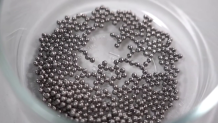It’s a serious danger that can fit in the palm of your hand: magnetic balls, now blamed for injuring thousands of children across the country.
The rare-earth, high-powered magnets made headlines years back when NBC 5 Responds found the toys were ending up in tiny hands. Those investigations even led to recalls and bans implemented nationwide.
But fast-forward to today, and those magnets are now back on store shelves, leading to a sharp rise in children having to go to the emergency room.

Some parents have learned about the high risks of having magnets in their home when it’s too late, like the Williams family out of north Texas. The Williams’ said recently a fun day of play with their youngest 4-year-old son Witten turned the family’s sense of safety upside down.
"I just looked over and saw that he was holding something shiny to his lips,” Witten’s mother Amber Williams explained. “He said, ‘Mom I accidentally ate them.’ And I was like, ‘Oh no, these are magnets.’”
At first, the Williams family said Witten seemed okay. The family decided to wait a day to see if the magnets would pass. But when they didn’t, their pediatrician sent them to the emergency room.

“They could see them on the X-ray scan, but they couldn't tell us exactly where they were,” Witten’s father Johnathan Williams said. “When three doctors come to get you from the waiting room, it's never good news.”
A laparoscopic search of Witten’s intestine revealed the magnets had made their way to his appendix. Doctors performed surgery to remove it. After three procedures, Witten is now recovering.
Feeling out of the loop? We'll catch you up on the Chicago news you need to know. Sign up for the weekly Chicago Catch-Up newsletter.
“It happened to be stuck in a place that's an organ that he doesn't even need. So, it really was the best-case scenario,” said Amber Williams.
I'd say we're probably seeing one or two of these cases a month. … It's quite terrifying.
Dr. David Troendle, Children’s Medical Center Dallas
Dr. David Troendle, one of Witten’s doctors at the Children’s Medical Center in Dallas, Texas, said these kinds of magnets are an eighth of an inch in size but can hold over 1,000 times their weight.
Making matters more dire, Troendle said his hospital is seeing more cases like Witten’s where children -- including teenagers -- swallow magnets.
There are signs that the same can be found in Chicago.
A spokesperson for Advocate Aurora Health told NBC 5 Responds that, based on data gathered from the Illinois Health and Hospital Association, three pediatric Chicagoland hospitals serving children – Advocate Children’s Hospital, Comer Children’s Hospital, and Lurie Children’s Hospital – all saw a higher percentage of pediatric patients with a diagnosis of a foreign body ingestion in 2020 compared with prior years.
The data did not specify whether the foreign bodies ingested were magnets, but doctors there said they’ve seen the problem firsthand; a product with a checkered past here in the U.S.
Cases Across The U.S.
Magnets injuring children is not a new problem. In 2014, NBC 5 Responds broke story after story about the dangers of high-powered magnets on the market getting into tiny hands.
Like 19-month-old Annaka Chaffin, who died when she swallowed several tiny magnetic balls, unbeknownst to her Columbus, Ohio, family.
After Annaka lost her life and after reports of thousands of children injured by magnet ingestion, the U.S. Consumer Product Safety Commission in 2014 deemed toy magnets and games made from rare earth elements a safety risk and recalled them from the market.
In the years that followed, magnet ingestions decreased by nearly 80 percent.
But in 2016, a 10th Circuit Court of Appeals decision shot down the CPSC’s rule, finding it was “incomplete and inadequately explained.”
Soon after, magnets found their way back on store shelves and advocates believe the impact of that court ruling on children’s safety is clear.
Data from the American Association of Poison Control Centers (AAPCC), obtained by NBC 5 Responds, show cases of magnet ingestions jumped by more than 530 percent in the years following the lifting of the magnet ban, between 2017 and 2021.
The stories behind each number are heart-wrenching for advocates like Nancy Cowles of safety non-profit Kids In Danger, who believe this could be prevented with federal intervention.
With regard to high powered magnets, Cowles said, “It's something that we believe should really just be taken off the market because the risks are much greater than any benefit of the product.”
Chicago-based Kids In Danger sounded the warning years back, and Cowles is concerned she has to say this again.
“The danger isn't necessarily recognizable to parents,” Cowles explained. “So they don't even think this is something dangerous.”
One small victory for safety advocates last month: the Consumer Product Safety Commission issued a mandatory recall of 10 million magnets due to ingestion hazards and risks of death.
But that recall only covered one company’s products. Cowles believes it doesn’t go far enough.
“We're glad to see that [the CPSC] took aggressive action on this. However, as I said, there are many other companies still selling these products,” Cowles said. “There's still a lot more work to do.”



